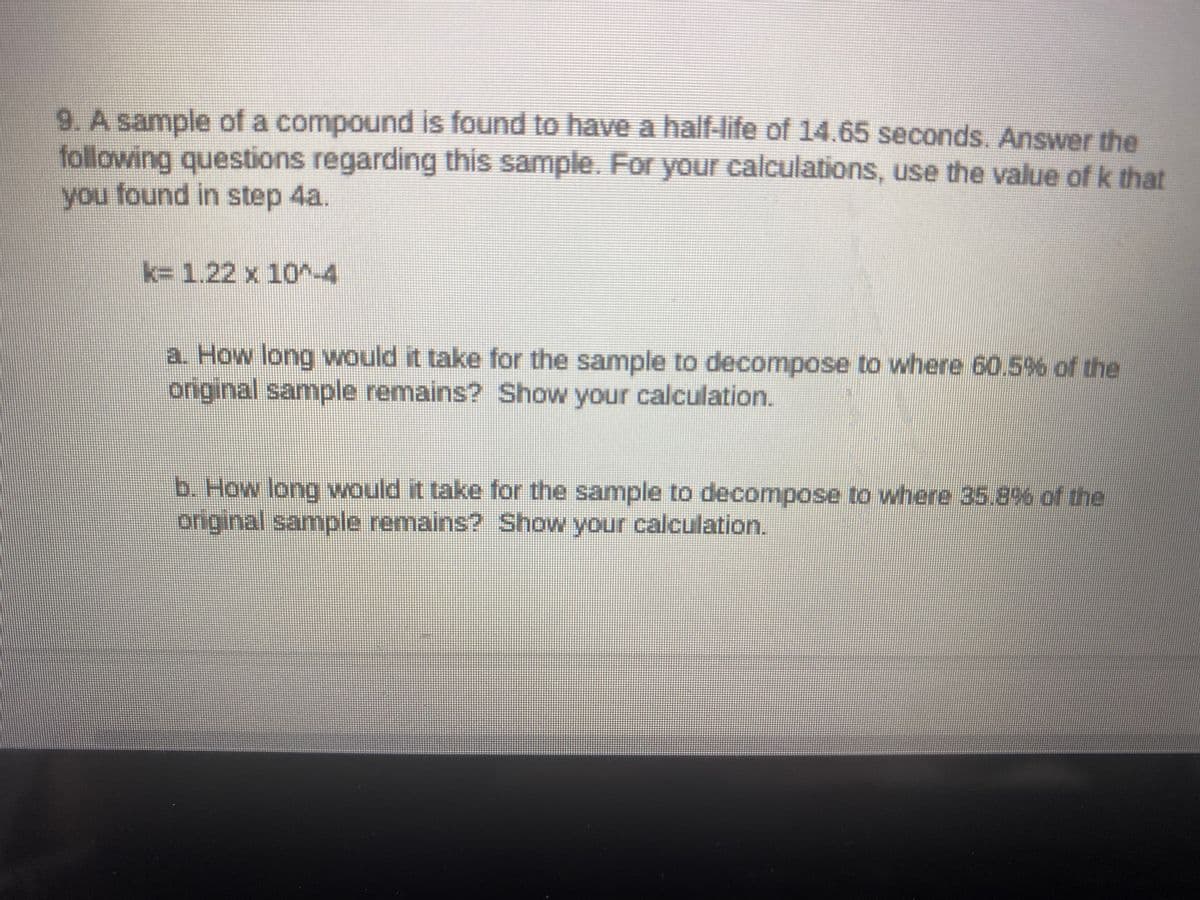9. A sample of a compound is found to have a half-life of 14.65 seconds. Answer the following questions regarding this sample. For your calculations, use the value of k that you found in step 4a. k= 1.22 x 10^4 a How long would it take for the sample to decompose to where 60.5% of the original sample remains? Show your calculation. b. How long would it take for the sample to decompose to where 35.896 of the original sample remains? Show your calculation.
9. A sample of a compound is found to have a half-life of 14.65 seconds. Answer the following questions regarding this sample. For your calculations, use the value of k that you found in step 4a. k= 1.22 x 10^4 a How long would it take for the sample to decompose to where 60.5% of the original sample remains? Show your calculation. b. How long would it take for the sample to decompose to where 35.896 of the original sample remains? Show your calculation.
Chemistry: An Atoms First Approach
2nd Edition
ISBN:9781305079243
Author:Steven S. Zumdahl, Susan A. Zumdahl
Publisher:Steven S. Zumdahl, Susan A. Zumdahl
Chapter18: The Nucleus: A Chemist's View
Section: Chapter Questions
Problem 54E: A chemist studied the reaction mechanism for the reaction 2NO(g)+O2(g)2NO2(g) by reacting N16O with...
Related questions
Question

Transcribed Image Text:9. A sample of a compound is found to have a half-life of 14.65 seconds, Answer the
following questions regarding this sample. For your calculations, use the value of k that
you found in step 4a.
k%3D1.22 x 10^-4
a How long would it take for the sample to decompose to where 60.5% of the
original sample remains? Show your calculation.
b. How long would it take for the sample to decompose to where 35.8% of the
original sample remains? Show your calculation.
Expert Solution
Step 1
This question is related to chemical kinetics.
A first-order reaction is a chemical reaction in which the rate is linearly dependent on the concentration of only one reactant.
Trending now
This is a popular solution!
Step by step
Solved in 2 steps with 1 images

Knowledge Booster
Learn more about
Need a deep-dive on the concept behind this application? Look no further. Learn more about this topic, chemistry and related others by exploring similar questions and additional content below.Recommended textbooks for you

Chemistry: An Atoms First Approach
Chemistry
ISBN:
9781305079243
Author:
Steven S. Zumdahl, Susan A. Zumdahl
Publisher:
Cengage Learning


Chemistry
Chemistry
ISBN:
9781305957404
Author:
Steven S. Zumdahl, Susan A. Zumdahl, Donald J. DeCoste
Publisher:
Cengage Learning

Chemistry: An Atoms First Approach
Chemistry
ISBN:
9781305079243
Author:
Steven S. Zumdahl, Susan A. Zumdahl
Publisher:
Cengage Learning


Chemistry
Chemistry
ISBN:
9781305957404
Author:
Steven S. Zumdahl, Susan A. Zumdahl, Donald J. DeCoste
Publisher:
Cengage Learning

Chemistry & Chemical Reactivity
Chemistry
ISBN:
9781337399074
Author:
John C. Kotz, Paul M. Treichel, John Townsend, David Treichel
Publisher:
Cengage Learning

Chemistry by OpenStax (2015-05-04)
Chemistry
ISBN:
9781938168390
Author:
Klaus Theopold, Richard H Langley, Paul Flowers, William R. Robinson, Mark Blaser
Publisher:
OpenStax

Chemistry & Chemical Reactivity
Chemistry
ISBN:
9781133949640
Author:
John C. Kotz, Paul M. Treichel, John Townsend, David Treichel
Publisher:
Cengage Learning